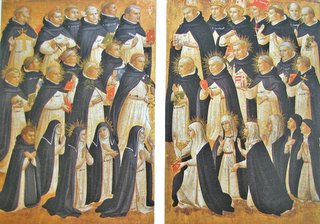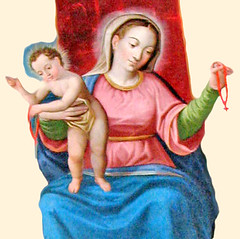"To paint the things of Christ, one must live with Christ."
 Sometime in the late 1390s, Guido di Piero was born near the village of Vicchio in the broad alluvial valley, known as the Mugello, that lies beyond the hills behind Fiesole, to the northeast of the city of Florence. Around 1415, he and his brother Benedetto were sent that great city of art where they trained in the manuscript industry. Benedetto was trained as a scribe and Guido was apprenticed as an illuminator. By 1417 his talent and fame had captured the attention of Battista di Baggio Sanguigni, a famed illuminator who sponsored Guido's entry into the lay confraternity of San Niccolo and Guido was already a noted painter and had commissions for altarpieces and miniatures.
Sometime in the late 1390s, Guido di Piero was born near the village of Vicchio in the broad alluvial valley, known as the Mugello, that lies beyond the hills behind Fiesole, to the northeast of the city of Florence. Around 1415, he and his brother Benedetto were sent that great city of art where they trained in the manuscript industry. Benedetto was trained as a scribe and Guido was apprenticed as an illuminator. By 1417 his talent and fame had captured the attention of Battista di Baggio Sanguigni, a famed illuminator who sponsored Guido's entry into the lay confraternity of San Niccolo and Guido was already a noted painter and had commissions for altarpieces and miniatures.Based on our knowledge of Guido's social and professional contacts in the manuscript industry and his own fame, we can surmise that he would have had a promising career ahead of him. However, sometime between 1417 and 1423 - possibly around 1420 when the Dominican convent of Santa Maria Novella was consecrated in Florence - Guido entered the strict Observance of the Dominican Order at their convent in Fiesole. The Observants were a reform movement of the Order of Preachers which had been instigated by St Catherine of Siena and her disciples. Upon taking the habit, Guido's name was changed to Fra' Giovanni da Fiesole, O.P., as a symbol of his having left the world behind. This was a custom introduced by the Observants in the early 15th-century. Interestingly, Benedetto also came to join the Order at San Domenico in Fiesole, but he retained his baptismal name; the two brothers were to collaborate on manuscripts which was the mainstay of their convent's income. It was in San Domenico that Br John met Fra' Antoninus Pierozzi who became prior of their convent and who would later become archbishop of Florence and subsequently canonised. It is noteworthy that Br John had actually been offered the See of Florence by Pope Eugenius IV in 1446 but he declined and suggested St Antoninus in his stead.
Around 1427, Br John was ordained a priest at San Domenico in Fiesole. Much of his early work was for the Dominican Order and his most important early commissions were for Dominicans churches and convents in Fiesole, Florence, Cortona and Perugia. By the early 1430s however he was working for non-Dominican patrons as well including the Medici of Florence. On top of his conventual duties - he was prior, subprior and syndic (bursar) at Fiesole - Fra' Giovanni da Fiesole also maintained one of the largest and most prestigious painter's workshops in Florence in order to cope with the demands for his work. Unlike his contemporaries, Br John's work was characterised by bright colours and a luminous quality, more often found in medieval illuminations; not surprising, given his initial artistic training. Pope Pius XII said that Fra Angelico's art was "radiant with the aura of peace, holiness, harmony and joy".
However, it seems that he was not motivated by ambition as an artist, which he could easily have fallen prey to, as he ran a highly successful and efficient studio. Indeed had he wanted success as an artist, he could have remained outside the Order. Thus, he was motivated by religious considerations and saw his art as a way to preach and to further the work of the Order. Fra' Giovanni is reported to have said: "To paint the things of Christ, one must live with Christ." Clearly he saw this as being accomplished within his religious life and his painting is a fruit of his contemplation, much as a scholar writes books and a preacher declaims a sermon as fruit of their study and meditation of the Word. Hence, Pope John Paul II said that Fra Angelico's art was "the fruit of that highest harmony which flowed from the combination of a holy life and a creative power."
In 1436 the Dominicans took possession of San Marco in Florence (which had been a Sylvestrine church) and it was then renovated for Observant use, an undertaking that was financed by Cosimo and Lorenzo de Medici. At the end of 1438, Br John arrived in Florence and was assigned to that convent which was then still legally joined to the Fiesole convent. Thus began his stupendous series of frescoes and paintings for the San Marco community, which was to comprise some of his most famous work, including the two pieces I have already discussed on this blog site. This work for San Marco has been described by John Saward as "a priceless gift for his brethren: he enabled them to have contemplative contact with the mysteries of the life of Jesus at every moment of their day." While at San Marco, Fra' Giovanni also served as conventual syndic under Fra' Antoninus, who was prior of San Marco from 1439 - 1444.
On 6 January 1443, the San Marco church was consecrated by a papal legate of Pope Eugenius IV who had just held an ecumenical Council in Florence. This same Pope celebrated the Mass himself and he so appreciated Br John's work that he summoned him to Rome to produce art for the Vatican palace and (old) St Peter's Basilica. So Br John set up his workshop in Rome, reaching the apogee of his artistic patronage as he served both Pope Eugenius IV and Pope Nicholas V who succeeded him in 1447. Sadly only the chapel of Nicholas V survives. While in Rome, Br John was assigned to the Dominican church of Santa Maria sopra Minerva. After a short stay in Orvieto where he decorated the cathedral with the assistance of Benozzo Gozzoli, he was recalled to Fiesole where his brother Benedetto, now prior of Fiesole, was gravely ill. Upon Fra' Benedetto's death, Br John was elected prior of Fiesole and served until 1452 when he was recalled to Rome by Cardinal John of Torquemada, the ecclesiologist. Interestingly, his nephew was the more famous Torquemada, Grand Inquisitor of Spain.
Cardinal Torquemada asked Br John to decorate the cloister of the Dominicans at Santa Maria sopra Minerva, which he began but never completed. Called home to the Lord on 18 February 1455, Fra' Giovanni da Fiesole, O.P., was buried in Rome at that church, just metres from the body of St Catherine of Siena who lies under the High Altar. Within a decade or so of his death, the distiguished poet and Latinist, Fra' Domenico da Corella called him "pictor angelicus", 'angelic painter', and he has been called "Angelico" ever since. Italians have long called him Beato Angelico, Blessed Angelico, but it was only in 1982 that Pope John Paul II, acting motu proprio, on his own initiative, confirmed the cult and he beatified Bl Angelico on 8 July 1983, assigning today as his feast.

In that 1982 Apostolic Letter, the previous Holy Father wrote that Fra Angelico lived "a life graced by his outstanding art and made even more honourable by his religious and human virtues. In the estimation of his peers he was a 'man of complete modesty and religious life'. Moreover 'he was esteemed for possessing a combination of virtues: meek by natural temperament, upright in religion'." It was these virtues in the life of Fra Angelico that elevated him to the ranks of the beati (depicted on left by Bl Angelico) and also to be considered one of the great artists of his time. Therefore Pope Pius XII said in 1955: "The genuine piety of Fra Angelico is rightly considered an essential basis for his success as a painter... His profound religious sense, his serene and austere asceticism nourished by solid virtue, contemplation and prayer... provided the power and immediacy with which his art spoke to the minds of others and, as has frequently been noted, transformed it into prayer."
Let us continue to ask this patron of artists to pray for us and for all those who serve God and His Holy Church in the arts.
"God of eternal beauty,
you inspired Fra Angelico
as an artist at the service of your truth.
May we delight in the beauty of his work
and rejoice in the glory of your creation.
We ask this through Christ our Lord."
Amen.
The depiction of Blessed John of Fiesole, O.P., above is by a student of the Dominican-run Holy Rosary College in Tala, the Philippines and formed part of their annual art exhibition.







0 Comments:
Post a Comment
<< Home